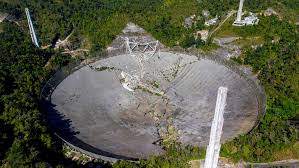
Puerto Rico’s massive Arecibo telescope, famous for its stellar contributions to astronomy, collapsed, leaving many among the scientific community in shock and anguish. The collapse was devastating also for many Puerto Ricans, for whom the observatory was culturally significant.
Daily Current Affairs Quiz 2020
Key-Points
The second-largest single-dish radio telescope in the world, Arecibo was first built in 1963. The US National Science Foundation owned the telescope.
Being the most powerful radar, scientists employed Arecibo to observe planets, asteroids and the ionosphere, making several discoveries over the decades, including finding prebiotic molecules in distant galaxies, the first exoplanets, and the first millisecond pulsar.
In 1967, Arecibo was able to discover that the planet Mercury rotates in 59 days and not 88 days as had been originally thought.
In 1993, scientists Russell Hulse and Joseph Taylor were awarded the Nobel Prize in Physics for their work on the observatory in monitoring a binary pulsar, providing a strict test of Einstein’s Theory of General Relativity and the first evidence for the existence of gravitational waves.





